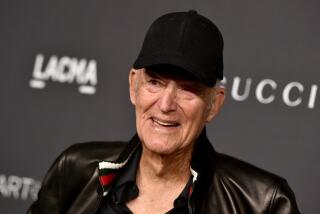Tange’s Honor Is Well-Deserved
- Share via
Following the announcement of most architecture awards there almost always is an echo of disagreement out of the persnickety profession.
Be the award local, state, national or international, relatively minor or prestigiously major, someone usually sidles up to offer a never-for-the record,supercilious criticism of the winning designer or design.
It both amazes and depresses me how in private, architects tend to trash one another, questioning the creativity, sincerity, intelligence and ability of their colleagues while, of course, promoting their own work, creativity, sincerity, etc.
But happily not always.
Such a welcome exception came last week with the announcement that Kenzo Tange has been named the 1987 laureate of the Pritzker Architecture Prize, which, with its $100,000 tax-free grant, has become the profession’s equivalent of the Nobel Prize.
If anything, the feeling was that the prize to the 73-year-old renowned Japanese architect was long overdue.
In his distinguished career, Tange has produced an impressive body of works, beginning in 1949 with the Peace Center in Hiroshima, then in the 1950s doing a series of singular civic structures across Japan, expanding in the 1960s and 1970s to include an Olympic sports complex in Tokyo, a world’s fair in Osaka, an airport in Kuwait and numerous buildings in the Middle and Far East.
Recent projects of note include commercial developments in Singapore and Sydney, Australia, and a sublime hotel in Tokyo. On Tange’s drawing boards at present are designs for a new city hall in Tokyo, an art museum for Yokohama, a commercial complex in Malaysia and a university in Bahrain.
The range of works over the years makes it very difficult, if unfair, to label Tange’s style. “Given talent, energy, and a sufficiently long career, one may pass from being a breaker of new ground to being revered as a classic,” declared the Pritzker jury citation. “This has been the happy fate of Kenzo Tange, who, in his seventh decade, is celebrated as an architect of international stature.”
The jury headed by J. Carter Brown of Washington’s National Gallery and including architecture critic Ada Louise Huxtable and architect Kevin Roche, added that “his stadiums for the Olympic Games held in Tokyo in 1964 have been described as among the most beautiful buildings in the 20th Century.”
Tange’s urban designs also have been noteworthy, and include master plans for Hiroshima, Skopje, Yugoslavia, the Fiera district of Bologna, Italy, and the expansion of Tokyo. The latter, in 1960, was quite theoretical--calling for mega-structures branching into the city’s bay--and quite controversial.
As with most of his designs then and now, the plan was in response to Tange’s concern that growth somehow be shaped to be more sympathetic to humanistic needs and also to permit change. It has been Tange’s contention that creativity should be “expressed in our time as a union of technology and humanity.”
Though he has worked on plans for the inner harbor of Baltimore, a sports and cultural complex for New York City and Yerba Buena Center in San Francisco, Tange’s only completed project in the United States is an expansion of the Minneapolis Art Museum. It was completed in 1975.
In downtown Los Angeles, in a way, he is represented by the new and stunning Museum of Contemporary Art, which was designed by one of his former students, Arata Isozaki. One senses in that design Tange’s comment of a few years ago that “architecture must have something that appeals to the human heart, but even then, basic forms, spaces and appearances must be logical.”
I suspect there also will be a touch of Tange’s tantalizing logic in the ambitious World Trade Center under construction in Long Beach, designed by Ross/Wou International in a joint venture with the firm of DMJM. The partner in charge of the project is Michael Franklin Ross, who, as a Fulbright scholar in the early 1970s, spent two years at Tokyo University serving as a teaching assistant in Tange’s design studio.
Ross described Tange as a patient teacher, who “with the humility of a great man that he is,” gave credit where credit was due.
In his definitive book, “Beyond Metabolism: The New Japanese Architecture” (McGraw Hill),” Ross notes that when he asked Tange to explain the similarity between a series of sketches Isozaki had done for a theoretical problem in 1962 and a very real project Tange had designed in 1966, the architect replied, “we influenced each other.”
Tange, like most architects, has been known to borrow design ideas from others, but as the Japanese that he is, he refines those ideas so that the final product very much bears his signature.
“The role of tradition is that of a catalyst, which furthers a chemical reaction, but is no longer detectable in the end result,” Tange has commented. “Tradition can, to be sure, participate in a creation, but it can no longer be creative itself.”
There had been concern a few years ago that the relatively young award--the Pritzker is in its ninth year--would drift, like so many other architecture awards to who and what is trendy and become immersed in the arcane politics of the profession and its personalities.
The award going to Tange gives the prize new international stature, and is welcome.
More to Read
The biggest entertainment stories
Get our big stories about Hollywood, film, television, music, arts, culture and more right in your inbox as soon as they publish.
You may occasionally receive promotional content from the Los Angeles Times.










